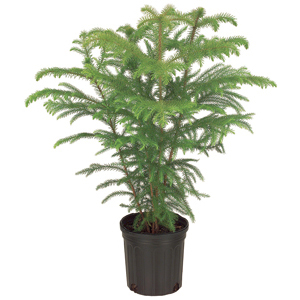Caring for a Norfolk Island Pine
So you picked up a Norfolk Pine before winter and it looked great until about two weeks ago when you noticed the needles beginning to fall off. Where did you go wrong? Let’s take a look.
General Care
Light Requirements: Norfolk Pines enjoy medium light. But what exactly is medium light? Well, don’t let your pine sit directly in front of an east- or south-facing window and keep it about five feet from all other windows.
Watering: Many sources will tell you to water once a week but I find this ambiguous. Your watering frequency will depend on the humidity in your house and the time of year. During the winter your tree is not really growing so allow the soil to dry out before watering again. From spring to fall, water more frequently to promote healthy, even growth. During this time, water when the first inch of soil has become dry. Norfolk Pines prefer high humidity so mist your plants once a week or more frequently if you notice that needles are turning brown.
When you water your plant, place it in a container to hold the water that runs through the soil. Let your plant sit in that water for no more than one hour. This allows the roots to pull up any extra water they need.
Fertilizing: As with any plant, fertilize your pine when it is actively growing (between spring and fall). Every two weeks, provide your pine with a mild fertilizer made for indoor plants.
Temperature: These pines prefer cooler temperatures and consistency: avoid drafts and vents and allow it to enjoy about 18°C.
Repotting: Norfolk Pines aren’t fond of re-potting and can keep their size in the same pot for many years before needing an upgrade. Check the root system of your pine every few years. If the root ball is bound and there is little soil left, consider re-potting. Always re-pot in the spring and use a fast-draining potting soil mix for best results.
The Usual Problems
The most common problem is needle browning resulting from overwatering, underwatering, or too much sun. Keep a close eye on your watering habits! Mist your plant regularly.
Remember…
1. Brown needles will not turn back to being green. As soon as they start to brown, they have finished growing and will soon fall off.
2. Be careful with pruning: all growth stops at any point that has been pruned so only remove dead branches and brown tips.
3. Always use cool water for general watering and misting.




